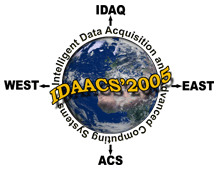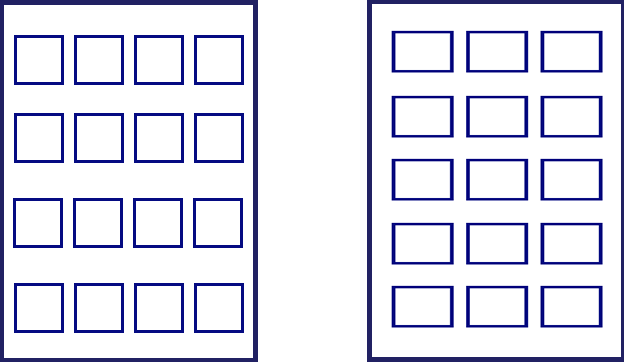|
INSTRUCTIONS AND GUIDELINES FOR PARTICIPANTS
If you have any further question, please, do not hesitate to contact
the Organizing Committee by email idaacs@tanet.edu.te.ua OR by our external account idaacs@yahoo.com.
| DOWNLOADABLE STUFF: |
|
|
| A. ORAL PRESENTATION GUIDELINES * NEW ! |
The presenters have come in the assigned meeting room at least
15 minutes before the session to meet the Session Chair and receive the last
minute instructions. If you have electronic presentation you should pass it to the
Organizing Committee. Note that Microsoft PowerPoint format ONLY
is acceptable for the presentations. The following
short guidelines for the oral presenters will help to have the uniformly high-standard
presentations at the Workshop.
- 1. Prepare visual aids (transparencies or electronic
presentation). Use approx. 8-10 mm high (or even higher) letters on the transparencies
(the single of typewritten texts is usually too small for overhead projection). Avoid
presenting long proofs or detailed derivations in the visual material.
- 2. Do not read your submitted written text word by
word, since the Proceedings will be in the hands of the audience. It is preferable to
point out only the basic ideas and/or heuristic explanations.
- 3. In case you cannot attend the Workshop, please
notify us in advance.
- 4. Prepare and print a short biography including
your affiliation and main activities (not more than 100 words). Give it to the chairman
during the pre-session meeting.
- 5. During the oral presentation: Inform your
audience with a few introductory sentences about the broader significance of your
paper. Speak as slowly and simply as possible. Keep a check on your presentation time.
Approx. 15 minutes will be reserved for your oral presentation, but if you can present
your contribution in a shorter time, please do so. Your presentation will be followed
by a short 5-minute discussion. Allow sufficient time for slides and projections.
Explain each figure and give the audience enough time to understand a figure before
going on to other topics. When summarizing your presentation, talk about the practical
benefits of the results of your work. Please respect your chairman's instructions during
the presentation, particularly in keeping your time limit.
|
| B. POSTER PRESENTATIONS GUIDELINES |
According to the timetable of IDAACS'2005 Workshop program,
the poster presentations are scheduled every day after oral presentations.
The poster presentations are divided on sessions according to their subjects.
At the same time (in parallel mode) poster sessions will be available every
day. Each poster presentation is placed on the special board, two presentations
on each side of the board (front and back). The working area of
the board is 130 x 91 cm (91 x 36 inches). There are three possible
ways for location of poster presentation:
1. 16 pages of A4 format (297 x 210 mm)
with portrait orientation;
2. 15 pages of A4 format with landscape orientation;
3. Including adequate number of pages with
A3, A2, A1, A0 format.
It is recommended to use the scotch
for fixation of the poster presentation. Each poster presentation
has to be started with title, printed by large font (typically 36-points).
Then it is necessary to present name of authors, affiliations and
contact information (phones, faxes, e-mails or post address). During
preparation of poster presentation please provide its clearness.
Short, informative sentences should be used. Pictures, graphs, diagrams
should be used to highlight the main results of the presentation.
|
| HINTS FOR PREPARATION |
What to illustrate?
Introduce your problem. What led to your work? What were your objectives?
Outline your solution. How did you do it? Bring out what is unique in your approach.
Emphasize your salient points using as much technical language as possible, to interest people not directly working in the area of your presentation.
Describe advantages and disadvantages of your methods and devices.
Avoid large equations. Clarify / justify your assumptions. Present test data,
if available, to support your theory / assumptions.
How to illustrate?
Do not copy your paper as it appears in the conference proceedings. Nobody will read it.
For optimum legibility, use modern bold type. Ariel or Sans Serif type is twice as easy to read as Roman or Script type.
Test the legibility of the material you should be able to read your poster paper it from a standing position about 2 meters.
Use tables and diagrams and figures for, which require explanation.
|
| SOME POSSIBILITIES HOW TO COVER THE POSTER TABLE |
|
| INSTRUCTIONS FOR COMPLETING THE IEEE COPYRIGHT FORM |
- Print your paper number (e.g., #i05-020) in the upper right corner of the form.
- Fill in the paper title and the names of all authors.
In the "IEEE Publication Title" type "IDAACS'2005 Proceedings".
- Sign your name in the space for "Author/Authorized Agent for Joint Authors" or in the space for "Authorized Signature". Type your name below your signature.
- Type the date in the "Date" field.
- If applicable, the "U.S. Government Employee Certification" and the "Crown Copyright Certification" should be also filled and signed.
- The IEEE is enforcing strict copyright rules. Electronic forms and signatures will not be accepted.
NO PAPER WILL BE PUBLISHED WITHOUT THE SIGNED COPYRIGHT FORM.
|
|




